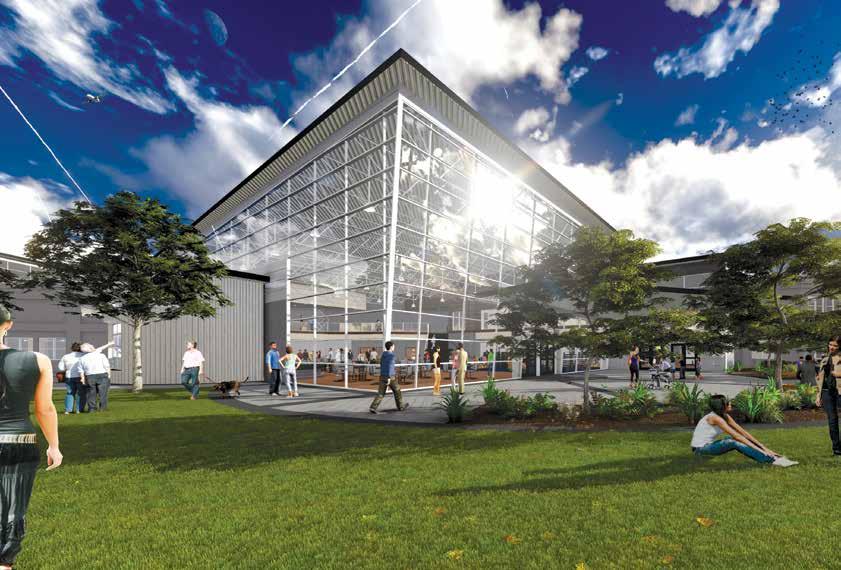
4 minute read
Transition to 21st century learning
By JuSTin dyck, archiTecT aiBc, chP archiTecTS
As architects specializing in educational facility design, we’ve engaged in seminars and educational sessions touting the benefits of 21st century design. While architects, planners and school districts generate excitement over the new direction of these flexible and real-world educational spaces, we ultimately tend to notice a disconnect between the design intent and the actual use of these spaces by the educators and students. Our company is taking a new approach to engage educators, students and parents in the design process to look past trends of 21st century learning and towards a deeper understanding of how educators deliver their program and how students learn.
learning with educators
School districts aim to train both veteran and new teachers in the 21st century teaching methods of education and we believe there is a strong place for designers to better engage educators and students in the design of learning spaces and help transition them into the new 21st century learning atmosphere.
Our office has taken a more integrated approach by accompanying educators in their own professional development endeavours to gain a full appreciation and understanding of how they currently deliver educational content and their thoughts of the 21st century of delivery.
We have recently shadowed 12 educators through a segment of their 21st century professional training to truly learn firsthand their impressions on this form of educational practices and how the programs are transitioned into their schools. We accompanied our clients to a one-week professional development trip to High Tech High, birthplace of project-based learning, which was specifically structured to educate teachers on the delivery of project-based learning. Through this experience, we gained an appreciation for what excited teachers about this form of learning, their apprehensions and frustrations, and their strategies for implementation.
Our experiences through this process allowed for a deeper understanding from a teacher’s perspective as we continue to work with the group to develop a new 21st century middle/ secondary school in Abbotsford.
Engaging students in design
As a continuation of our educational research, we are now engaging students in the design process to essentially help design their own school. Through a new initiative called IDEA, in coordination with Abbotsford Christian School in Abbotsford, the architect/educator team is engaging current students to participate in the design of their new school.
Through a series of joint sessions with our firm’s design professionals and school educators, a select group of students from middle and

secondary programs will work through a series of design and research exercises. This will provide direct insight into the daily lives of students and the qualitative aspects to be incorporated into the school design.
Over a four-month period, the students will work on qualitative exercises through multiple media and eventual practical spatial designs to define the configuration of the learning spaces they will ultimately occupy. The mini projects will look to decipher the qualitative aspects of modern school life by challenging the students to creatively articulate what scares them about school, what inspires them, what makes them feel comfortable or uncomfortable, what makes them feel nervous or anxious, and other current themes. The series of projects will be presented by the students to the team to explore the potential impact the built environment can have in reinforcing desirable qualitative aspects.
The projects will then evolve into the more technical design aspects and translate into the design of real spaces throughout the school. The students will work with the architectural team to detail plans, elevations, and perspectives of learning spaces and articulate the spaces they want to learn in.
At the end of the process both the students and our professional team will present the new school design to the student and parent community through an open house and town-hall presentation. Students will present their ideas and field community questions. Through this process, the parents and larger community will have a direct connection and engagement with the design of the school.
While our role as architect has traditionally involved some building systems training primarily aimed at the school’s facilities and operations staff, we’re finding a greater benefit to offer direct training to educators and students on use of 21st century design aspects within their facility. We’ve toured enough facilities where operable walls are never opened and flexible furnishings that never vary from traditional row alignment to see the break between design intent and implementation.
Educational staff professional development is an obvious necessity, but as architects we can certainly do more to help the transition. Our firm now offers occupant training directed at educators to explain and demonstrate the physical design features of 21st century learning. The function of operable walls, flexible furniture arrangements, multiple teaching positions in the classrooms and 21st century technologies can be greatly enhanced with a little follow-through to bridge the gap for educators to a new facility. This new service will be employed on the Abbotsford school project.
A holistic process
21st century learning is a new concept for designers, policy makers, educators and administrators across the board. Through the transition to this new way of educational delivery, great care should be taken to engage with educators, students and parents through the design process to look past trends and discover how teachers are actually incorporating new learning techniques, and how students view the new 21st century learning environment. The key themes of collaboration, technology, engagement and sustainability should be incorporated throughout the design process as a precursor to actually educating in the spaces created. The architect’s role must continue through construction services to provide training on these new facilities and the
bring learning to LIFE
transition into occupancy
intent behind the design. n
ARCHITECTURE & LANDSCAPE ARCHITECTURE www.chparchitects.com 604-793-9445











